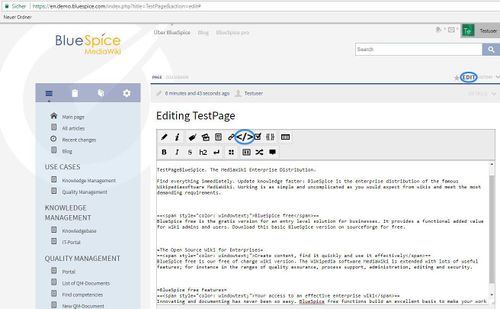Blog
-
- Last edited 6 years ago by MLR
-
-
- This page is a first draft
Contents
What is Blog?
Blog extension allows creating news feeds on the wiki. These news feeds can be shown on any page, and users can be allowed to add their own news.
Blog by default
By default, there is a link to the Blog page in the TopMenuBar, which then opens the blog, a page containing a form for writing a new blog entry and a list of previous entries.
Display Blog on any wiki page
This blog news feed can be displayed on any wiki page by adding the blog tag to the page.
This also displays a "Create new blog entry"-form on the page, unless it is disabled to use blog tag attributes.
A blog entry consists of a title, revision information (date and author of first revision), the entry itself and possibly links for comments and a permalink.
If a blog entry is too long, the link "continue reading" is displayed.
Blog tags
Blog extension offers several tags. These tags can be added to a page using InsertMagic functionality, or writing tag syntax directly to wiki code editor.
| Wiki tag | Description |
|---|---|
| <bs:blog /> | Displays blog news feed on the page. It can be extended with multiple attributes. For more on attubutes read section "Blog tag attibutes" below. |
| <bs:blog:more /> | This tag should be placed inside the content of a blog entry (pages in Blog namespace) to define at which point in text "continue reading" link should be placed. This will override default cut-off length of an entry. |
| <bs:blog:time time="YYYYMMDDHHmm" /> |
This tag also should be placed inside the content of a blog entry. It allows manually defining timestamp for that particular blog entry. Timestamp is used in sorting and displaying blog entries. |
Write an entry or create a new entry
New blog entries can be created through the form on the page containing a blog tag, on Blog special page (Special:Blog), or by directly creating new pages in the Blog namespace.
Creating a second blog
As described the default blog feed consists of "normal" wiki pages stored in the Blog namespace. Other blog feeds can exist in addition to this feed, and they can be defined by category.
For example, the category "Company news" can be designated for a second blog. In that case all pages in this category will be considered entries of this blog and will be displayed on page as blog entries. By adding <bs:blog /> tag to the page, attribute "cat" must be set to "Company news" like <bs:blog cat="Company news" />
Another option is to designate a namespace for this purpose. Using example from above, namespace "Company news" must be created and all pages inside this namespace (Company news:News1, Company news:News2) will be considered blog entries. The syntax that should be used for the blog tag in this case is: <bs:blog ns="Company news" />
Keep in mind that when blog tags with "cat" or "ns" are used, all pages from that category/namespace will be shown, so those categories/namespaces should be used for that purpose only.
<bs:blog /> attributes
The following tag arguments can be used with the tag <bs:blog />:
| Attribute | Description | Value |
|---|---|---|
| count | Number of blog entries to be displayed. | number |
| cat | Category from which to show pages as blog entries | category name |
| ns | Namespace from which to show pages as blog entries | namespace name or ID |
| newentryfield | Should "Create new blog entry" be shown? | 0 or 1 |
| newentryfieldposition | Position of the "Create new blog entry" form. | "bottom" or "top" |
| renderimages | Should images be displayed | 0 or 1 |
| maxchars | Number of characters that should be shown before the "Continue reading" link is shown. | number |
Default values for these attributes for the whole wiki can be set in the global BlueSpice preferences. See Reference page.
Tips for working with blogs
Put a link to the blog in the left hand navigation menu. Then your colleagues will be able to find the blog whenever they want.
See also
Our reference page.





